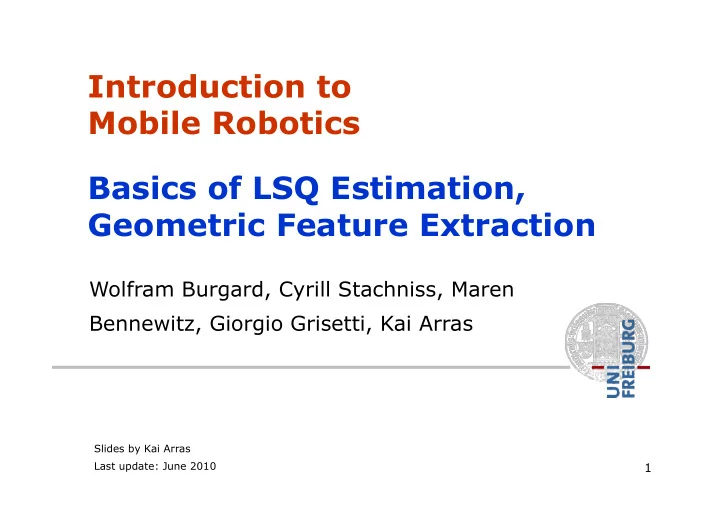

Introduction to Mobile Robotics Basics of LSQ Estimation, Geometric Feature Extraction Wolfram Burgard, Cyrill Stachniss, Maren Bennewitz, Giorgio Grisetti, Kai Arras Slides by Kai Arras Last update: June 2010 1
Feature Extraction: Motivation Landmarks for: • Localization • SLAM • Scene analysis Examples: • Lines, corners, clusters: good for indoor • Circles, rocks, plants: good for outdoor 2
Features: Properties A feature/landmark is a physical object which is • static • perceptible • (at least locally) unique Abstraction from the raw data... • type (range, image, vibration, etc.) • amount (sparse or dense) • origin (different sensors, map) + Compact, efficient, accurate, scales well, semantics − Not general 3
Feature Extraction Can be subdivided into two subproblems: • Segmentation: Which points contribute? • Fitting: How do the points contribute? Segmentation Fitting 4
Example: Local Map with Lines Raw range data Line segments 5
Example: Global Map with Lines Expo.02 map • 315 m 2 • 44 Segments • 8 kbytes • 26 bytes / m 2 • Localization accuracy ~1cm 6
Example: Global Map w. Circles Victoria Park , Sydney • Trees 7
Split and Merge 8 Picture by J. Tardos
Split and Merge Algorithm Split Obtain the line passing by the two extreme points • Find the most distant point to the line • If distance > threshold, split and repeat with the left and • right point sets Merge If two consecutive segments are close/collinear enough, • obtain the common line and find the most distant point If distance <= threshold, merge both segments • 9
Split and Merge: Improvements Residual analysis before split • : start-, end-, break-point Split only if the break point provides a "better interpretation" in terms of the error sum [Castellanos 1998] 10
Split and Merge: Improvements • Merge non-consecutive segments as a post-processing step 11
Line Representation Choice of the line representation matters! Intercept-Slope Hessian model Each model has advantages and drawbacks 12
Fit Expressions Given: A set of n points in polar coordinates Wanted: Line parameters , [Arras 1997] 13
LSQ Estimation Regression, Least Squares-Fitting Solve the non-linear equation system Solution (for points in Cartesian coordinates): → Solution on blackboard 14
Circle Extraction Can be formulated as a linear regression problem Develop circle equation 15
Circle Extraction Leads to overdetermined equation system with vector of unknowns Solution via Pseudo-Inverse (assuming that A has full rank) 16
Fitting Curves to Points Attention: Always know the errors that you minimize! Algebraic versus geometric fit solutions [Gander 1994] 17
LSQ Estimation: Uncertainties? How does the input uncertainty propagate over the fit expressions to the output ? X 1 , ..., X n : Gaussian input random variables A, R : Gaussian output random variables 18
Example: Line Extraction Wanted: Parameter Covariance Matrix Simplified sensor model: all , independence Result: Gaussians in the parameter space 19
Line Extraction in Real Time • Robot Pygmalion EPFL, Lausanne • CPU: PowerPC 604e at 300 MHz Sensor: 2 SICK LMS • Line Extraction Times: ~ 25 ms 20
Recommend
More recommend